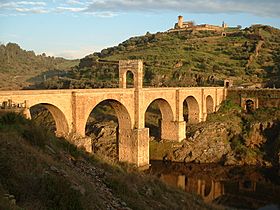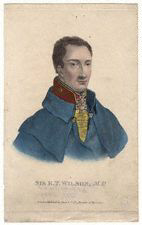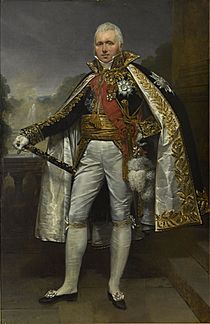Battle of Alcántara (1809) facts for kids
Quick facts for kids Battle of Alcántara |
|||||||
|---|---|---|---|---|---|---|---|
| Part of the Peninsular War | |||||||
 The Roman-built bridge at Alcántara |
|||||||
|
|||||||
| Belligerents | |||||||
| Commanders and leaders | |||||||
| Units involved | |||||||
| Strength | |||||||
| 9,500, 12 guns | 2,000, 2–6 guns | ||||||
| Casualties and losses | |||||||
| light | over 269, 1 gun | ||||||
Template:Campaignbox Peninsular War (1809-2010)
The Battle of Alcántara took place on May 14, 1809. It was a fight between French soldiers led by Marshal Claude Perrin Victor and Portuguese troops under Colonel William Mayne. The battle happened during the Peninsular War, which was part of the larger Napoleonic Wars.
The French attacked the Portuguese near the Alcántara Bridge in Alcántara, Spain. This town is on the Tagus river, close to the border with Portugal. After about three hours of fighting, the French managed to cross the bridge. This forced the Portuguese soldiers to retreat.
At the time, Marshal Nicolas Soult was invading northern Portugal. Two other French forces were ready to help. General Pierre Belon Lapisse's division was near Ciudad Rodrigo. Marshal Victor's soldiers were in the Tagus valley. A small British-Portuguese force watched these French groups.
Colonel Mayne's Portuguese troops occupied Alcántara. Victor thought Mayne's group was a big threat. So, he marched his army to attack them. The Loyal Lusitanian Legion fought bravely at the Alcántara Bridge for three hours.
The French cannons then silenced the Portuguese guns. A group of Portuguese militia soldiers ran away. The bridge had explosives placed on it. Mayne ordered them to be set off, but the strong old bridge did not break completely. French soldiers then rushed across the partly damaged bridge. The French stayed in the area for a few days before leaving. The next major battle was the Battle of Talavera.
Contents
Why Did the Battle of Alcántara Happen?
The French Plan to Invade Portugal
In 1807, France had already invaded and taken over Portugal. But this ended in August 1808. British forces, led by Sir Arthur Wellesley, defeated the French at the Battle of Vimeiro. The French army then left Portugal.
Later, in October 1808, a British army led by Sir John Moore went to Spain. They wanted to help Spain fight against Emperor Napoleon's rule. Moore's mission ended when he died at the Battle of Corunna in January 1809. However, his army won the battle and was able to leave safely.
Napoleon planned a new invasion of Portugal for early 1809. He wanted three French armies to attack. Marshal Nicolas Soult's 20,000 soldiers would come from the north. General Pierre Belon Lapisse's 9,000 men would attack from the northeast. Marshal Claude Victor's army would march from the east.
Napoleon expected Soult to capture Porto (Oporto) by February 5, 1809. From there, Soult was supposed to march to Lisbon. Lapisse was told to capture Ciudad Rodrigo and Almeida, Portugal. Victor was ordered to be in Mérida. He was to send a group to Lisbon. Napoleon thought these armies could easily talk to each other. But he did not consider that Spanish and Portuguese fighters might stop their messages.
Soult began his march south on January 30, 1809. His army entered Portugal on March 9. They won battles at Braga on March 20 and the First Battle of Porto on March 29. Soult took Porto, but his communication lines were cut. He did not know where Lapisse was.
Other Important Events Before the Battle
Meanwhile, Marshal Victor won a big victory at the Battle of Medellín on March 28, 1809. He then took over Mérida. But Victor told King Joseph Bonaparte that he did not have enough soldiers to invade Portugal. He asked for Lapisse's division to join him.
When the main British army left Portugal, a small group was left to defend it. Colonel Robert Wilson and 1,200 Portuguese soldiers were in the northeast. Wilson refused to leave. Instead, he guarded Almeida and bothered Lapisse's approaching division. Lapisse thought he was facing 12,000 enemies, so his attack stopped. Victor finally got permission to take control of Lapisse's division. Victor ordered Lapisse to move south and join him. On their way, the French soldiers looted Alcántara.
On April 22, Wellesley took command of the British army in Portugal. His army quickly grew to 23,000 men. Wellesley decided to attack Soult first. He sent 18,500 soldiers to fight Soult. Another 6,000 men under William Carr Beresford helped. To watch Victor in the east, Major General Alexander Randoll Mackenzie was given 12,000 soldiers.
Mackenzie watched the Portuguese border from Abrantes. His force included British cavalry and infantry, plus Portuguese cavalry and infantry. Colonel William Mayne's Portuguese troops were an outpost for Mackenzie's corps. Mayne had about 2,000 soldiers and six cannons. They came from the mountains and moved into Alcántara.
The Battle at Alcántara Bridge
The old Roman bridge over the Tagus River at Alcántara was very important. It connected northern and central Extremadura. Victor thought Mayne's small group was the start of a big attack. So, on May 11, he set out to deal with them.
Victor's army had about 9,500 men and 12 cannons. This included Lapisse's division and a group of dragoons (cavalry). Mayne's force had about 1,850 men, including some cavalry and only two cannons.
On May 14, Victor's soldiers met Mayne's outposts. They quickly pushed them back. Mayne did not try to defend the town of Alcántara itself. Instead, he dug in his troops on the north side of the Tagus river. He also placed explosives and barriers on the bridge.
Victor decided to weaken the Portuguese defenses with artillery fire before sending his infantry. The French cannons and infantry began shooting across the river at Mayne's troops. The Portuguese fought strongly for three hours. Around noon, the Portuguese militia soldiers panicked and ran away. Mayne then ordered the explosives on the bridge to be set off.
After the smoke cleared, the strong old bridge was still standing. One side of an arch was gone, but the bridge was not completely destroyed. By this time, the French cannons had knocked out one of Mayne's cannons and silenced the others. Victor ordered one of Lapisse's brigades to rush the bridge. When the French soldiers managed to cross and get a foothold on the north bank, Mayne ordered his troops to retreat. They pulled back to the Salvaterra Pass.
What Happened After the Battle?
The Loyal Lusitanian Legion battalion, which had 1,000 men, lost three officers and 103 men killed. Five officers and 143 men were wounded, and 15 men went missing. The losses for the militia were not recorded. The Portuguese also lost one cannon. French losses are not known.
Victor realized that Mayne's small force was not a big threat. The French only went a few miles past Alcántara. This worried Mackenzie, who thought he was about to be attacked. But Wellesley told him not to worry. Victor did not have enough soldiers to seriously threaten Mackenzie's position. After three days near Alcántara, Victor pulled back.
While Victor was away, a Spanish force tried to attack Mérida. But they failed to remove two battalions of German soldiers from a fortified building.



